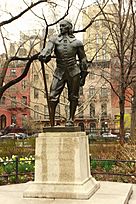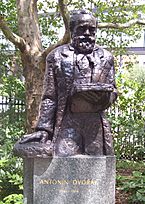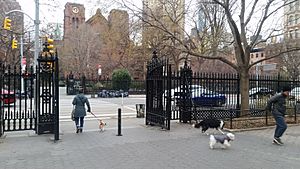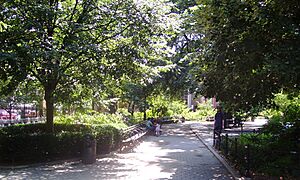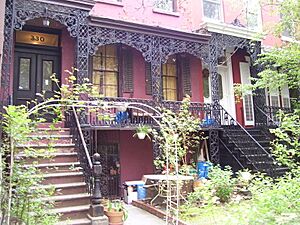Stuyvesant Square facts for kids
Quick facts for kids Stuyvesant Square |
|
|---|---|
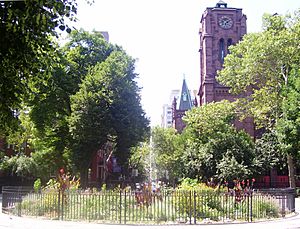
The central fountain in the western portion of the park; the park is bisected by Second Avenue. In the background is St. George's Episcopal Church
|
|
| Location | Between 15th Street, 17th Street, Rutherford Place, and Nathan D. Perlman Place, Manhattan, New York City |
Stuyvesant Square is a special place in New York City. It's both a beautiful park and the name of the neighborhood around it. You can find this park in the Manhattan area of the city.
The park sits between 15th Street and 17th Street. It's also bordered by Rutherford Place and Nathan D. Perlman Place. A big street called Second Avenue cuts the park into two parts: an east side and a west side. Each part is surrounded by a very old, cool-looking cast-iron fence.
The neighborhood around Stuyvesant Square has its own borders. It generally stretches from 14th Street in the south to 18th or 19th Street in the north. To the east, it reaches First Avenue, and to the west, it goes to Third Avenue. This area is part of a larger community district in Manhattan.
Contents
Exploring the Neighborhood's Location
The Stuyvesant Square neighborhood is easy to find on a map. It's located south of 20th Street and north of 14th Street. You'll find it east of Third Avenue and west of First Avenue.
To the east of Stuyvesant Square is a large housing area called Stuyvesant Town. To the west, you'll find the lively Union Square area. And if you head south, you'll reach the unique East Village.
A Look Back: History of Stuyvesant Square
The story of Stuyvesant Square began in 1836. A man named Peter Gerard Stuyvesant, who was a descendant of the famous Peter Stuyvesant, and his wife Helen set aside four acres of their family farm. They sold this land to New York City for just five dollars! They wanted it to be a public park, and it was first going to be called Holland Square.
There was one important rule: the city had to build a fence around the park. But years went by, and no fence appeared. So, in 1839, the Stuyvesant family actually sued the city to make them build the fence! Finally, in 1847, the city started to improve the park. They put up a huge, 2,800-foot-long cast-iron fence. This fence is still there today and is the oldest cast-iron fence in New York City!
In 1850, two beautiful fountains were added, and the park officially opened to the public. Stuyvesant Square joined other important public spaces like Washington Square Park. These parks were meant to be the center of New York's nicest neighborhoods.
In the early 1900s, living near Stuyvesant Square was very fashionable. Famous people, like publisher George Putnam and Harper's Bazaar editor Elizabeth Jordan, lived in the area. Even Elizabeth Custer, the wife of General George Armstrong Custer, lived there.
More people moved to the area when St. George’s Church opened nearby in 1848. The Friends Meeting House and Seminary also opened in 1861. The oldest houses in the area were built around 1842. This was when New York City's homes started to spread north of 14th Street. Most of the neighborhood grew in the 1850s.
Even in 1883, fancy houses were still being built. However, around this time, many immigrant families started moving into the neighborhood. These included people from Germany, Ireland, and later, Jewish, Italian, and Slavic families.
Many hospitals were once located in this neighborhood. Dr. Elizabeth Blackwell, a pioneering woman doctor, founded the New York Infirmary for Women and Children here. While some hospitals have changed or moved, the Hospital for Joint Diseases is still in the area. Because of all the hospitals, there were many doctors' offices on the side streets.
The Park's Features and Care
Stuyvesant Square Park got a big makeover in the 1930s. Changes were made to make it more useful for everyone. Things like restrooms and playgrounds were added. The park officially reopened in 1937.
In the 1980s, the park was restored again. The two fountains from 1884 were fixed, and the old cast-iron fence was preserved. The original bluestone sidewalks were relaid, and the lawns, shrubs, and flower beds were refreshed. Some very old trees, like English elm and Little-leaf linden, are still growing strong there.
The park also features two important statues. One is of Peter Stuyvesant, created by Gertrude Vanderbilt Whitney in 1941. The other is a statue of the famous composer Antonín Dvořák, which was moved to the park in 1997.
The New York City Department of Parks and Recreation takes care of the park. Also, the Stuyvesant Park Neighborhood Association works hard to help keep the park beautiful for everyone who visits.
Buildings Around the Square
Right around Stuyvesant Square, you'll find some important buildings. These include the Friends Meeting House and Seminary and St. George's Episcopal Church. Famous people like J. P. Morgan once attended St. George's Church.
On the east side of the park is Beth Israel Medical Center. Part of this medical center was built where the famous composer Antonín Dvořák once lived in 1893. Nearby, you can also see the old Stuyvesant High School building, which is still used for education today.
The area around Stuyvesant Square is so special that it was named the Stuyvesant Square Historic District in 1975. This means the buildings and the park are protected because of their history. The Friends Meeting House, St. George's Church, and the old Stuyvesant High School are all official New York City landmarks. There are also three beautiful brick houses on East 18th Street that are landmarks. They were built in 1852–1853 and have lovely front yards and iron porches.
See also
 In Spanish: Stuyvesant Square para niños
In Spanish: Stuyvesant Square para niños


